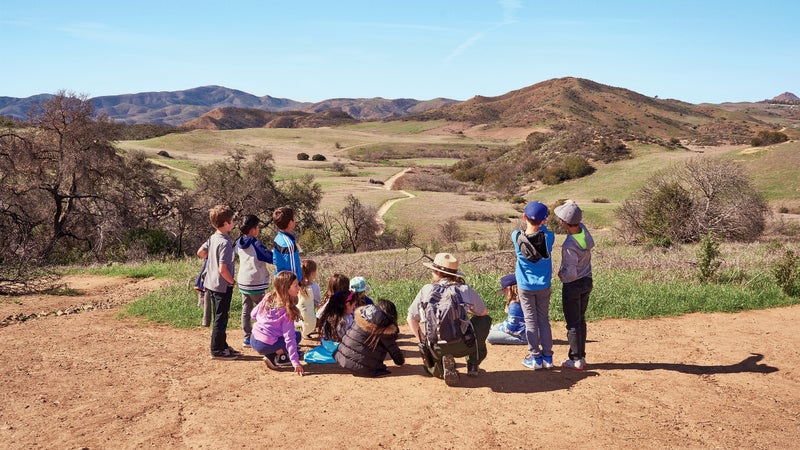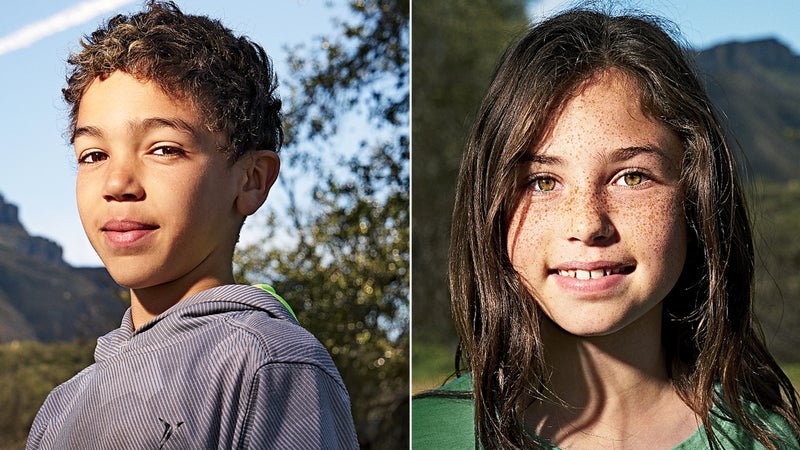The National Parks Have a Serious Youth Problem
A new initiative gives complimentary national park access to every fourth-grader in America. Can a class field trip turn kids into lifetime fans of the outdoors? Mike Kessler hops on the yellow bus—and endures high-decibel Bieber sing-alongs—to find out.
New perk: Easily find new routes and hidden gems, upcoming running events, and more near you. Your weekly Local Running Newsletter has everything you need to lace up! .
It isn’t until the bus lurches to a halt at the entrance to Santa Monica Mountains National Recreation Area, near Los Angeles, that the kids realize they’ve arrived. That’s how it is on a field trip. You pile in, buckle up, and try your best to use your quiet restaurant voice, even when traffic on the 101 is stop-and-go for an hour and you don’t have to be in class all day and the driver was nice enough to crank up the radio.
Just look at Jordyn or Athena or Harlowe. They’ve been singing along with Justin Bieber and Maroon 5 and Adele and everything KIIS FM has thrown at them since we pulled away from Mar Vista Elementary at 9 a.m. A few rows up, Justice, Seth, and Cameron have been talking, with unrestrained ten-year-old gusto, about whatever it is ten-year-olds talk about, while the rest of the fourth-graders have been grooving or clowning. But when the driver brakes and cuts the volume, a moment of near silence overtakes all 35 of them.
Oh. My. God. We’re here!
The kids on the left press their faces to the windows, peering out at the scrubby, oak-dotted hills and canyons, both of which are particularly green thanks to a recent gift from El Niño. Across the aisle, the other kids squirm for a better view, resisting the urge to undo their seat belts. That’s when ranger Mary Calvaresi climbs aboard, dark green cargo pants, wide-brimmed hat, and all.
“OK, everyone,” says Ranger Mary, who’s 32 and has no kids of her own, but speaks with the loving, patient authority necessary to address a busload of children. “If you can hear me, put your hands on your head.”
The kids—22 boys and 13 girls—do as they’re told, because Mary makes it fun.
“Put your hands on your shoulders… Hands on your ears… Hands on your heads.”
Now she’s got ’em. Even their teacher, Miss Treves, is impressed. And man, if these fourth-graders dig nature as much as they like this game, they’re going to love what comes next.
Today’s field trip to the Satwiwa region of the Santa Monica Mountains is part of a White House initiative called , a program that gives every fourth-grader in the country, and their families, free entry to all the national parks, monuments, waterways, and recreation areas in the U.S. for the 2015–16 school year—with the hope of extending the offer to fourth-graders in perpetuity. To spread awareness, the privately funded National Park Foundation is underwriting a field-trip campaign for resource strapped schools, shouldering the transportation costs required to host 130,000 kids.
The initiative is meant to address a confluence of 21st-century realities: 80 percent of U.S. families live in urban areas, where poverty, traffic, lack of regional transportation, hyper-scheduled childhoods, or some combination thereof makes it harder than ever for kids and families to get to wild spaces. Compounding the problem, kids today spend less time outdoors and more time glued to screens than they have since, well, the advent of screens. And they’re paying a mighty price—in high rates of clinical anxiety, depression, and ADHD, in low test scores and vitamin D deficiency, even in compromised distance vision. Call it what you like—the perils of modern life or nature-deficit disorder—but the science is abundant and unequivocal: children do better with a dose of the natural world in their lives.
That’s why the program targets fourth-graders. Nine- and ten-year-olds are more mature than third-graders, but not nearly as jaded, distracted by hormones, or downright bratty as fifth-grade tweens can be.
Call it what you like—the perils of modern life or nature-deficit disorder—but the science is abundant and unequivocal: children do better with a dose of the natural world in their lives.
“Fourth grade is when they’re old enough to appreciate being exposed to new things,” says Julia Washburn, the National Park Service’s associate director for interpretation, education, and volunteers. “It’s the right age because it’s when they really have that sense of wonder.”
Visitation statistics collected by the Park Service don’t account for children’s ages, so there is currently no data on the number of fourth-graders who have taken advantage of the Every Kid In a Park program. The three Los Angeles–area divisions of the NPS, where Ranger Mary helps coordinate the youth-education programs, have, since the start of the initiative last summer, introduced three new programs for fourth-graders and set a goal to get 10,000 of them to local public lands in the next year. The field trips take place all over the Santa Monica Mountains, but Rancho Sierra Vista/Satwiwa is a local gem. You might recognize the name from 2013, when the Springs Fire torched 24,238 acres of the Santa Monica Mountains between Highway 101 and the Pacific Coast Highway. This stretch, which sits just inside Ventura County, was one of the hardest hit. Thousands of sycamores, eucalyptus, and oaks were incinerated, their leaves turned to ash and their limbs blackened.
But three years later, on the day of the Mar Vista Elementary trip, the native and exotic grasses are a healthy light green. Poppies are beginning to sprout. Prickly pears and chollas are revealing their purples and yellows across a sloping mesa, giving way to the hillside oaks and willows that survived the burn and whose richer greens soften the visual impact of the charred flora. None of the kids even notice or ask about the funny-looking, fire-damaged trees in the distance.

“OK,” says Mary, holding up an acorn for 12 of the kids to see. “Who can tell me what an acorn is?” A dozen little arms shoot toward the sky. Me! me! me! This is the Coastal group, not to be mistaken for the similar-sized Inland or Island groups that are off with other rangers doing other activities. Coastal’s trip begins on the shaded stone patio of the park’s cultural center, near the picnic tables and a native plant garden.
“An acorn is a food that squirrels eat,” says Ava, with far more caution than she used when belting out hits on the bus.
“That’s right,” says Mary, adding that Native Americans—Chumash Indians, to be exact—also ate acorns.
“Who can guess how long ago the Chumash lived right here in this park?”
“A hundred years ago?” says a boy sitting cross-legged, who’s hidden by the show of hands.
“Great guess,” says Mary. “But wayyyyy more than that.”
“Since the dinosaurs?” asks a girl.
“Not quite that old,” says Mary.
Their arms are still up, wiggling like garden eels.
“One million years?”
Nope.
“Nine thousand years?”
Getting warmer.
When Cameron finally guesses 13,000 years, Mary calls for a round of applause. The four chaperone moms, whose eyes are locked on their iPhones, look up, clap a few times, then return to Facebook.
Mary throws the kids a true-or-false question: “The homes the Chumash lived in were called tepees.”
“That is so false,” says Mason.
“Another round of applause, please!” says Mary. “The Chumash lived in aps, which is pronounced ops. Let’s go see one!”

While the field trips are intended to expose kids to the unbridled possibilities of the great wide open, you can’t just turn a class of fourth-graders loose in the wilderness for two hours and tell them to meet back at the bus when time is up. Yet while it might appear as though the Coastal group is being micromanaged, herded from one place to the next, on closer inspection you see that they’re given the leeway to let their eyes and ears and minds wander.
“Some of these kids have never been in the outdoors,” says Mary, who joined the Park Service in 2009, after earning her BA in environmental science and resource management from California State University, Channel Islands. “So if a kid is seeing a red-tailed hawk or is fixated on a bee landing on a flower while I’m talking, it’s not a sign of disrespect. That indicates to me that something big is happening, so I give them the space.”
Keeping the noise level down isn’t nearly as challenging as it was on the bus. Within seconds everything is remarkably calm.
That much is clear as we stand under the dome-shaped ap. The group is rapt as Mary talks about the many uses of yucca. She calls it the grocery store plant, owing to its versatility. The thin fibers are woven with grasses into rope that holds the structure together. She passes around a switch, stopping at Tommy to note that his rope necklace once looked more like the plant in her hand. When Tommy smiles, his eyes simultaneously squint and sparkle.
Then Mary drops a trick question. “Can anyone guess what the Chumash used to make the doorway to the ap?”
The kids lob their guesses. Yucca? Oak branches? Cactus?
“Nope,” Mary says. “They used the ribs of a whale!”
The kids scan the arid-looking landscape, considering how a cetacean might make it all the way here. Mary tells them that the ocean is just on the other side of the Santa Monica Mountains. After explaining that the Chumash hung animal skins from the whale-rib arches to make doors, she asks, “What would happen if you slept in the ap without a door?”
“You could get robbed,” a girl says. “Or you could get taken.”
It’s a disheartening answer but not a surprising one. Mary hosts field trips twice a week from October to May, and her students run the demographic gamut. While many have never been to a national park, others, like roughly 60 percent of the kids at Mar Vista Elementary(according to a show of hands), have had some exposure. Tucked between highly gentrified Venice and Culver City, Mar Vista is a leafy, working-class neighborhood. Back when busing still existed, the school held Title I (read: low income) status, but these days parents move across town to live near it. Nevertheless, this is L.A., so the girl’s street smarts are a matter of course.
Ranger Mary praises her practical guess. “The real reason,” she says, with what feels like an extra dose of good cheer, “is to keep out rain and rodents like squirrels or mice.”
By around 12:30, the Coastals move on to the trip’s big adventure—a half-mile out-and-back hike from the ap to a water tank that’s about 100 vertical feet up toward 2,838-foot Boney Peak. A trail runner could make it there in five minutes, but Mary draws it out with a series of ecology lessons.
“Can you feel the sun on your face?” she asks a minute or two in. The kids had just been instructed to turn themselves into plants, spreading far enough apart so they can stretch out their arms, their faces absorbing heat from the burning yellow star in the sky.
Affirmative. “Great. Now turn around and tell me if it feels the same.” The kids pivot. No, they concur. Looking this way feels different.
Mary explains that the relationship between local plant life and the sun are different, too. The south- and west-facing flora, which get the majority of the light, are mostly chaparral. The oak trees and toyons and green brush that get less sun are called coastal sage scrub. They mostly face north.
At another stop, she points out a prickly pear. Marlo speaks up. “Can you eat a prickly pear?” Her voice is almost muted by a steady breeze that has blown the smog out of the Conejo Valley basin, providing a clear view all the way to the Santa Susana Mountains.
“You can eat one,” says Ranger Mary. “But you have to take the spines off first.”
Someone giggles.
Up the trail, the group gets to sample some of the area’s moisture-absorbent chia seeds, which the Chumash would suck on during long hikes to avoid carrying heavy loads of water. Mary asks what the seeds taste like.
“Tastes like tea,” says Athena.
“Taste like blood,” says Rose, who is diabetic and has to prick her finger daily for blood-sugar readings.
“They’re bland,” says one of the boys.
After everyone weighs in, Marlo pipes up. “I make chia pudding at home.
Finally, arriving at the water tank, the group takes a knee and listens as Ranger Mary outlines the importance of nature. She talks about oxygen and natural resources and safe habitats for animals to live, even though the wildlife today is lying conspicuously low.
“Does everyone think nature should exist even if we can’t always get to it?” she asks.
Her question is met with a collective, mumbly, “Yes.”
“Does anyone disagree?”
Nope.
Mary says they’d better get back if they want to have lunch before the bus leaves. But this time the hike is going to be different. “When we reach the shaded woodlands,” she says, “we’re not going to talk at all. We’re just going to walk in silence, so the only thing we hear is our footprints.”
Keeping the noise level down isn’t nearly as challenging as it was on the bus. Within seconds everything is remarkably calm. The kids gaze in all directions—at a smear of clouds overhead, at the rock band of Boney Peak over their left shoulders, at the oak-shrouded hills that lead to the Pacific, and at the windswept grasses that line the trail. A moment later they’ve spread out a bit, the way grown-up hikers do when they’re tired of talking. It’s anyone’s guess how many of these kids will take to this kind of recreation, let alone go on to become rangers or environmentalists. But there’s no doubt that, at this moment, every one of them is perfectly content, taking it all in, as if by nature.
Tomorrow, back in class at Mar Vista Elementary, the students will write their Field-Trip Reflections. Marlo, the chia gourmand, will note that her seeds tasted “like watermelon, lemon, and lavender.” Gordon will happily report that, while “we didn’t see much animals, there were a lot of plants” and a “really fast caterpillar and some hummingbirds.” Samy will explain that “the following fact may not be about the Chumash, [but] it’s sure interesting that in California, one way people divide Native people into tribes is by the language they speak.”
Everyone will say they loved the hike, and many will recall the crafts portion of the day, when they gathered at the picnic tables and made necklaces out of abalone shells. Emi will sum it up pretty well: “All the activities were so awesome and fun, especially the jewelry making. I had so much fun and I hope to come back soon.”


